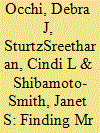| Srl | Item |
| 1 |
ID:
174114


|
|
|
|
|
| Summary/Abstract |
The NHK morning drama Massan features a male protagonist who unrelentingly pursues his dream of making Scotch whisky with Japanese-grown ingredients. After spending two years studying whisky-making in Scotland, he returns to Japan in 1921 with his Scottish wife, Ellie. Over the course of the drama, we follow Masaharu Kameyama as he develops as a craftsman, a husband, and a father. Drawing on explicit statements made by the characters about husbands and fathers, this paper focuses on the conduct and culture of fatherhood as represented in Massan. Focused attention is given to three central male characters in the drama: merchant Kinjirō Kamoi, aspiring artisan Ei’ichirō Kamoi, and Masaharu Kameyama himself. Specific attention is given to dialog that focuses on work, work–life balance, and stereotypical roles of husbands and wives. We find that due to the presence of a foreign wife, overt communications regarding husband–wife roles and fathers’ responsibilities take place. Moreover, we discover that the story of one Japanese man and his foreign bride offer a bridge from the 1920s to present-day issues surrounding men’s non-performance in the domestic sphere.
|
|
|
|
|
|
|
|
|
|
|
|
|
|
|
|
| 2 |
ID:
100296


|
|
|
|
|
| Publication |
2010.
|
| Summary/Abstract |
Language standardization lies at the heart of Japanese modernity. And numerous aspects of language development intended to fit the modern Japanese state intersect to regiment the linguistic imaginary regarding women's speech. Focus on Yamanote Tokyo-based joseigo ('women's language'), Standard Japanese and certain urban Kansai dialects in popular text and televisual representations of romantic heroines in geographically and linguistically peripheral areas of Japan has been documented, but has left the issue of linguistic masculinity and the romantic hero unexplored. The relation of male speakers to hyo-jungo was assumed and 'masculine' speaking practices as broadcast in public space have received little attention despite a popular understanding that certain forms (e.g., ore 'I', and assertive sentence final particle zo) are 'masculine' in effect. Here, we examine images of manly men in contemporary romantic representations set in dialect-speaking areas to illustrate the linkages between the romantic hero and the use of Standard Japanese masculine forms and to offer insight into the underexplored set of possibilities for male speakers circulated in popular media.
|
|
|
|
|
|
|
|
|
|
|
|
|
|
|
|